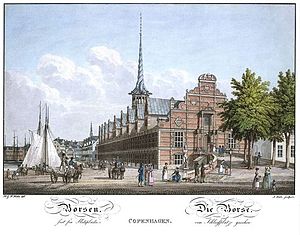Storm on the Stock Exchange
 From Wikipedia - Reading time: 4 min
From Wikipedia - Reading time: 4 min
| Storm on the Stock Exchange | |||
|---|---|---|---|
 | |||
| Date | 11 February 1918 | ||
| Location | |||
| Caused by | High levels of unemployment | ||
| Methods | Direct action | ||
| Resulted in | Leaders fined, some prison sentences received | ||
| Parties | |||
| |||
| Lead figures | |||
| |||
| Number | |||
| |||
The Storm on the Stock Exchange was a violent attack on the Børsen in Copenhagen on 11 February 1918. The attack was organized by unemployed syndicalists.
Background
[edit]Great inequality in society intensified during World War I. There was high unemployment, rationing, housing shortages and lack of fuel, and the unemployed received little support. At the same time, speculators could make huge sums of money. Denmark was neutral and exported food to Germany with great profits. During 1918, the syndicalists were behind a series of unemployment demonstrations. The first unemployment demonstration under syndicalist leadership took place on January 29, 1918, and went from Grønttorvet to the Riksdag in Fredericiagade. According to Solidaritet, 35,000-40,000 took part in this demonstration, and although this number may be exaggerated, the demonstration was undoubtedly large.[1][2]
Storming
[edit]The storming took place on Shrove Monday 1918 and started from two meetings in Folkets Hus on Jagtvej 69 and Arbejdernes Forsamlingsbygning in Rømersgade. Only the leaders knew where the demonstration procession was going, and to fool the police, they leaked that the target was the Pork Hall, which was to be looted.[3] The demonstration was led by the syndicalists Andreas Fritzner, Poul Gissemann and Alfred Mogensen, and it ended with a spontaneous storm on the Stock Exchange. The participants were armed with clubs, and they walked into the Stock Exchange and attacked the stockbrokers.[4] Later, they attacked the police with rubble from the construction site to the third Christiansborg.
The attack was organized by, among others:
- Andreas Fritzner,[5] from the Trade Union Opposition Association and Young Socialist Association (USF).
- Poul Gissemann from the Trade Union Opposition Association
- Jørgen Mortensen from the Young Socialist Association
- Christian Christensen from Trade Union Opposition Association
The leaders were punished with fines of 500 kroner, what Andreas Fritzner called "a ridiculously small Punishment". Five others received sentences ranging from 120 days to two years in prison.
Reactions and further processes
[edit]The storming of the stock exchange made a great impression on the contemporaries and especially bourgeois politicians and media distanced themselves from the revolutionaries. Illustreret Tidende compared the storm with the ravages of the Red Army and looting in the Finnish Civil War, which was at its height, and added: "On the 259th anniversary of the assault on Copenhagen, we experienced the Danish storm on the stock exchange. It is truly time that the bourgeoisie again awakens."[6]
After the storming, the syndicalists formed the Organization of the Unemployed (D.A.O.) which received great support. The syndicalists' struggle for the conditions and rights of the unemployed culminated in November 1918. The syndicalists had convened a protest meeting on 10 November at Grønttorvet, which gathered 50,000 participants,[1] and again on 13 November, where 30,000-40,000 participated.[7]
References
[edit]- ^ a b Petersen, Carl Heinrich (1973). Fra klassekampens slagmark i Norden. Til arbejderbevægelsens historie (in Danish). Vol. 1. Århus: Modtryk. OCLC 782935947.
- ^ Scherfig, Albert; Damkjær, Nicklas (10 February 2018). "11. februar 1918: Da arbejdsløse stormede Børsen" (in Danish). Dagbladet Information. Retrieved 5 March 2021.
- ^ KH5 p. 186
- ^ Scherfig, Albert. "Stormen på Børsen 1918" (in Danish). The Workers Museum.
- ^ "Andreas Fritzners øjenvidneskildring". Stormenpåbørsen.dk. 17 January 2018. Archived from the original on 3 August 2020. Retrieved 5 March 2021.
- ^ "Kampen for de Nationale Rettigheder". No. 7. Illustreret Tidende. 17 February 1918.
- ^ Petersen, Carl Heinrich (1974). Danske Revolutionære (in Danish). Vol. 2 (3rd ed.). Copenhagen: Borgen. ISBN 9788741846231. OCLC 462046408.
External links
[edit]- Rigsarkivet: Udtagne sager J. Den ungsocialistiske og syndikalistiske bevægelse 1903-1919
- Andreas Fritzners egen beretning i det socialistiske leksikon.org
- 102 års oprør, Ungern Avis, Ungdomshuset, dec. 1999 (archive.org)
- Albert Scherfig, Arbejderbevægelsens Arkiv & Bibliotek Arbejderhistoriske Temaer: Stormen på Børsen 1918 (bl.a. Tidslinje), 2018
- Nicklas Damkjær & Albert Scherfig: 11. februar 1918: Da arbejdsløse stormede Børsen, Dagbladet Information, 10. feb. 2018
- Lasse Bertelsen: Revolutionære Bølger, Socialistisk Standpunkt, 13.4.2003
- Daniell Marcussen: Da syndikalisterne mødte Lenin..., Speciale, Historie, (Kandidatuddannelse), Aalborg Universitet 2009
- Københavns Historie. Bind 5 – Under fælles ansvar. 1900-1945 af Sv. Cedergreen Bech mfl. Gyldendalske Boghandel 1981. ISBN 87-01-52591-3
- StormenPåBørsen.dk (bl.a. Kildepakker)
 KSF
KSF